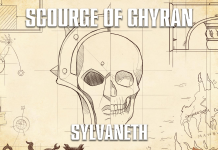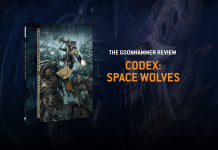Welcome back to another Crusade review. This one’s for all the Shas’os out there who believe that the entire universe must learn of your peaceful ways through the precise and prudent application of crushing military force. The Tau codex has your standard array of Battle Traits, Requisitions, and such, but also includes rules for claiming planets for the T’au empire and even a Name Generator, which we all love.
As always thanks to Games Workshop for providing us with a review copy.
Expanding the Empire
You will once again be embarking again on the epic task of pushing back the borders of the T’au Empire one planet at a time, by flexing either the Military might of the Fire caste’s warriors or the Diplomatic efforts of the Water caste until the entire Star System is in the clammy fishy grips of the T’au.
GREGNOTE: I’m going to start here by linking you to our coverage of the 9th Edition T’au Empire Codex’s Crusade Content and suggesting that you read that before continuing. The reason why will become apparent.
Beanith: Luckily, since it was one of the later 9th Edition codex to be released, this meant that the T’au got some pretty decent thematic crusade rules based around expanding their Empire via the application of Military or Diplomatic powers. I fully expect the same treatment for the Genestealer Cults and possibly the Drukhari whenever their codex eventually drops.
Starting out you will need to determine the temperament of the system’s inhabitants, whomst you are trying to welcome into the fold via carrots and long range shooty sticks, by rolling a D6 and consulting the Inhabitants’ Temperament table.
Results such as Warlike will increase the Military Power of every planet in this system, with Ideologues doing the same for Diplomat power (we’ll explain what those powers mean shortly). Trade Contacts will halve the amount of Diplomat power for one of the planets, making it that much easier to talk them around to embracing the Greater Good.
Determining the number of planets in the system has been changed from having to roll 2d3+2 to just letting you choose between 4, 6 or 8 planets. That may not look like there’s much difference, but it allows Campaign Masters an additional tool to help tweak things so they don’t quickly go off the rails. It’s also good news for those that are not lucky enough to have the chance to play as often, allowing them to tech into smaller systems and thus quicker loops, to keep up with the Marine players smashing out Campaign after Campaign (still rough to be a ‘nid player, we know).
Lastly, you now roll a D6 for each planet which decides if you then roll on the Common Planets table or the High-Value Planets table. The first planet you roll for will be the Core Planet, which really doesn’t mean much beyond it being the last planet you can take over in that System.
Each planet will have a Military Power value and a Diplomat Power value, which need to be lowered to zero in various ways. In addition to the Temperament roll, certain Assimilation Effects from conquering one planet can apply modifiers to the other planets in the system, but at the end of the day you’re stocking up on Points until you have enough to zero out one or the other on a planet, at which point it becomes yours. Military Power points can be earned by winning games but you can also use the Hit Their Supply Lines Agenda, whereas Diplomat Power points are typically earned via the Secret Meeting and Protect the Leadership Agendas.
Once you have reduced a planet’s Military or Diplomat values to zero, you will then have to process the Assimilation Abilities which will either help or hinder your efforts in taking control of the other planets in your Star System.
A prime example would be the Fleet Installation, with a Diplomat Power of 4 and Military Power of 6. Conquering this beast will set off the Assimilation Abilities Invasion Plan, which reduces the Military Power of another planet by half (rounding up), and Orbital Dominance, which gives a free use of the Rearm and Resupply Requisition. Compare this to the Shrine World, which has the effects of lowering 3 planets’ Diplomat power by 1 (that’s good), but also raising every planet’s Military Power by 1 (that’s bad).
Once you’ve conquered every planet in the system, either by force or guile, you can now use the Set Up Supply Lines Requisition to grab one planet’s Supply Line Effect for your Crusade force. By spending the 2 RP (or 1, if you selected the Core World’s effect) you gain a powerful bonus for your Order of Battle. The Political Centre’s Supply Line Effect is quite powerful, reducing the Diplomat Points of all planets in your next Star System by 1.
My favourite would be the Mining World’s Spoils of War. This nets you d3+1 Requisition Points. I can see a lot of fish folk using these bonus points to purchase the Legendary Veterans Req to make a squad of Crisis suits more deadly.
Of course, using Military Points to subjugate planets does mean there’s a chance you might blow up something important: each time you take over a planet via Military means, there’s a 50/50 chance you will destroy that planet’s Supply Line effect.
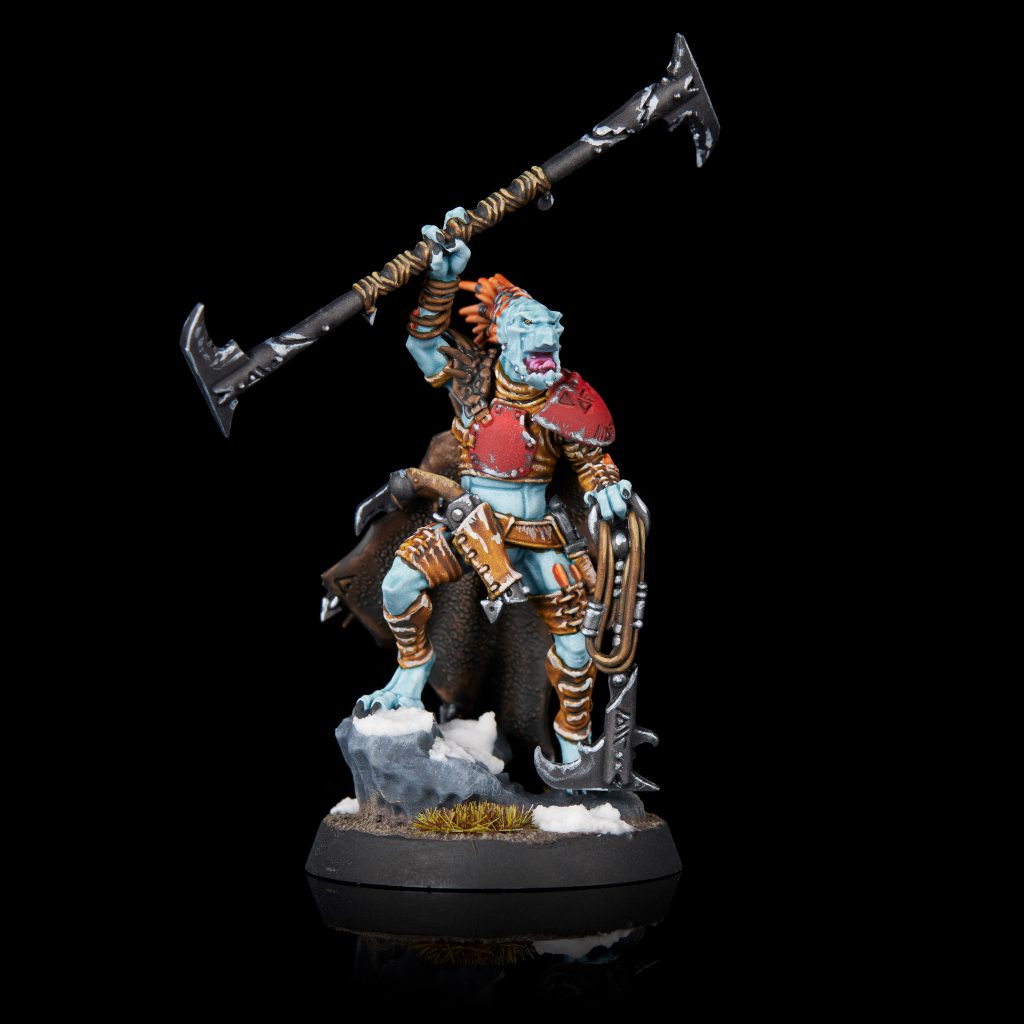
Greg: Now that Beanith has done the hard work of explaining how this whole thing works, I’d like to compare the late-9th edition and early-10th edition versions of this. The basic skeleton hasn’t changed much, no, but when we get down into the details, is it any different? Also no. To wit:
- Determining the Temperament of the Inhabitants: Is exactly the same.
- Determining the number of planets: Instead of rolling 2d3+2, you just pick, from 3 of the 6 values you could have rolled before.
- Determining the type of each planet: The dice-rolling mechanic has changed. I’ll talk more about this later because the changes are baffling.
- The planet types themselves: Are exactly the same, bar a couple of changes to make their effects work with the new rules (requisition names, swapping power level for points, etc). The Diplomat and Military power, the assimilation, the supply line, all of it: 100% identical to 9th except where needed to get them to work in 10th.
- Gaining Military and Diplomat points: Is exactly the same.
- Assimilation: Is exactly the same.
- Set Up Supply Lines (Requisition): Is exactly the same.
In our initial review of this content I thought this was a smart and characterful way to handle Crusade for T’au: it gives the Empire in-game mechanics to operate the way it’s been shown to work outside the game (ie, in the lore), and it gives the player some choices to make in the between-game bookkeeping phases, instead of passively watching a counter go up before cashing in their chips. The Diplomacy/Military routes to power are a lovely example of how the T’au operate, and a careful or careless reading of Assimilation Effects can make your life either much easier or much harder, respectively, allowing a smart player to create domino effects that ripple across a star system. It was, and remains, one of my favorite Crusade mechanics.
I had two complaints, most of which remain valid, and I’m now adding a third. The first was that I do not think “Diplomat Points” is a serious name for a resource. That is simply a ridiculous phrase, and always will be. The other is that I found Expanding the Empire to be a weaker version of the Genestealer Cult’s Day of Ascension, which does basically the same thing but slightly better. I’ve softened a bit on the latter, having played with this system more since writing that review, but the GSC’s Discovery mechanic had the ability to throw a wrench in your plans, which added a fun wrinkle that I think this one lacks.
My new complaint is just that, come on man, this is the same dang thing we already saw. You didn’t update it at all. The ability to simply decide the size of the elephant you’re eating (with all your choices still being in the same range you could have just rolled for) barely matters, and the changes to planet type generation literally don’t matter at all.
Beanith explained this already, but to recap: previously every planet had the same odds. There was a d33 chart (that is, roll 2d3 and take the combination in order – similar to a d100 chart from the Rogue Trader days), giving the same 1-in-9 chance to generate any given type of planet. In the new version you roll the dice sequentially: if the first is a 1-4, it’s a Common planet, and you roll a further d6 to choose which type, on a 5-6 it’s a High-Value planet and you roll a d3 on a different table.
The thing that’s weird about this is that it doesn’t actually change the odds on anything. The Common planets are a 1-in-6 after a 2-in-3, which is the same 1-in-9 chance as before (ie, two thirds of one sixth is, mathematically, one ninth). The High-Value planets are two 1-in-3 rolls in a row, which is also still a 1-in-9 chance (one third of one third) for any of them. You have the exact same odds of rolling any given planet as you did before, and the High-Value ones aren’t any more or less rare than the commons – they’re one third of the results, and you roll for them one third of the time. They did not do anything, but you are meant to feel that they did.
I will now stop harping on this being a low-effort re-print and review the rest of the content on its own merits, but I had to get that out of my system first.
Agendas
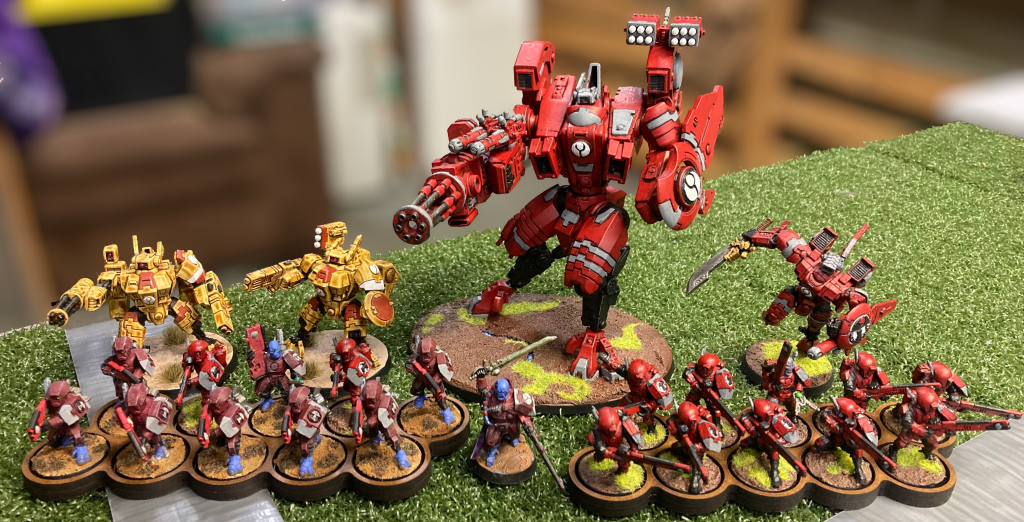
Tau get 5 faction specific Agendas they can take before the game.
Secret Meeting: At the beginning of the battle you pick an Ethereal you brought and it has to attempt to get to the center of the battlefield and sit there for a round, unable to shoot (something it wasn’t doing anyway) or charge (something it really wasn’t doing anyway). Doing this grants the ethereal 3XP and gives you either 3 Diplomat points in battle rounds 1-3, or d3 Diplomat points in rounds 4 and 5. This is a nice one since it gives you a mechanism to level up a support character in your army, which is something other armies sometimes struggle with. The way this is worded, you can do it a bunch of times, getting yourself 15XP and 9+2d3 Diplomat Points, if the Ethereal’s meeting takes long enough.
Protect the Leadership: This one’s a doozy. You put down two Dignitary Markers which represent political leadership. Each of these has three “life points”, which go down every turn that you don’t control the marker. When the life points hit zero, the dignitary presumably gets killed by the shock of being unattended, and the marker is removed from the battlefield. Keeping them alive gives you 2 Diplomat Points per marker and, if you saved both, an extra unit can be Marked for Greatness. I actually like this one a lot, mini-games via Agendas is one of the coolest things about crusade and this one handles it pretty well. The only downside I see is that Tau are generally a pretty mobile army that don’t want to necessarily battle for a marker in No Man’s Land if they don’t need to.
Hit Their Supply Lines: Here’s your classic “do Activities on objectives for points” agenda that we see pretty often. This one is limited to Tau infantry (Kroot included) and you get rewards for doing it on half the objective markers (D3 Military points) or all the objective markers (3 Military points). Solid but relatively unexciting.
Outflank and Encircle: Another straightforward one. Simply have more stuff in your opponent’s deployment zone at the end of the game than they do. Doing so earns up to three of those units 2XP (or 3XP if they’re Kroot). I can see a suit heavy list racking up a bunch of XP from this depending on the battle, and the Agenda generally plays into the Tau gameplan. On the other hand, the opponent will know what your goal is, and if they have the second turn they can just run back to their DZ at the end and deny this.
Teachings of War: The only real stinker of the bunch. The Agenda rewards you with 1XP per kill in either the first and fifth battle rounds – you have to choose at the start of the battle. The issue is in the first battle round your opponent is likely hiding all their stuff, and in the fifth battle round, if you’re doing well, you’ve probably killed all the units you were going to kill and at best will get 2XP from this.
Requisitions
There are four requisitions, and three of them are cool.
Show of Force (1RP): After winning a battle, trade 2 Military Points for 2 Diplomat Points. This isn’t complicated, but depending on the type of planets you’re trying to take over, it can be extremely useful.
Prototype System (1RP): When adding a BATTLESUIT unit to your Order of Battle, it immediately gains 6XP, giving it the Blooded rank and the right to select a Battle Trait from the Battlesuit Trait table (it specifically has to be that table). The Battlesuit-specific Battletraits aren’t all extremely inspiring, which we’ll cover later, but the ability to auto-slam a permanent buff on a brand new unit is so good that this feels like something you’ll be using early and often, unless you’re running a Kroot-sade, in which case you’ll want to scroll down a few paragraphs for a nice treat.
The Hero’s Mantle (2RP): This is the only one that gets a “ehhhh” from me, doubly so because it’s the most expensive one in the list. It’s from the unit-swap archetype of requisitions, here acting to remove a Crisis or Broadside unit and add a Crisis, Riptide, or Ghostkeel with the same XP, scars, honours, and crusade points as before. Games Workshop keeps trying to make this a thing, and other than a very particular subset of narrative sickos, it’s such a miss every time. If you want a Riptide with traits, just take a Riptide in the first place, you don’t need to dumpster some Crises first and steal their XP. Almost no one is going to use this, but the people that do use it are going to love it.
Totemic Infusions (1RP): The Kroot get a requisition about eating a dude’s brain, and it’s extremely good but also difficult to ever trigger. The restrictions are brutal: a) your Shaper has to b) kill the enemy Warlord c) in melee. If you pull it off, the Shaper gains a special battle honor based on the faction of the opponent. For example, if they manage to beat down a Votann Kahl, they grant +1T to their attached unit. Do the same to Aeldari, and their unit gets +2” to movement. You can only have one of these on a given Shaper – selecting a second will cause the first buff to fall off. This is exceedingly cool, but I worry that any character trying to pull this off is going to accumulate so many battle scars before they get it to work that it won’t end up being worth it.
Battle Traits
Four tables here, for Battlesuits, Ethereals, Infantry (Breachers, Strikes, and Pathfinders) and Kroot. Battlesuits get the full six-item table, everyone else gets three to choose from.
Beanith: I would have loved to have seen more granularity here between the differently sized Battlesuits or an acknowledgement that Kais isn’t weird for using gunships by providing a couple more Battle Trait tables. But since the space in the Crusade section is limited I understand sacrifices must be made.
Battlesuit Units

Sentry AI: Keeps your OC at 1 instead of 0 if you get battleshocked. Nice to have, but far from my first pick.
Warden Drones: This one’s gonna need an FAQ. The wording reads “once per battle this model” can reduce an incoming shot to zero damage. It’s currently unclear if that means every model gets one of these blanks, if it’s a typo and should say unit, or something completely different. For those of you playing at home and getting this, talk to your crusade arbitrator if you have one, but we recommend replacing “model” with “unit”. All that said, regardless of interpretation this is a really strong get. Incredibly funny on a Ghostkeel who can then do this three times a battle. Beanith: I wouldn’t hold my breath on waiting for an FAQ from GW on Crusade content but as mentioned it’s a fairly straight forward fix we’ve recommended.
Reactive Thrust System: Once per battle you can use the Heroic Intervention strat for free. I don’t know why you would ever want your battlesuits to waste a slot on an ability that gets them stuck in melee but here we are. GREGNOTE: Pair it with the Onager Gauntlet I guess? Otherwise I agree that this is extremely weird. Beanith: I know right, this was such a wasted opportunity. It should have been ‘roll a d6 when charged and on a 4 or 5+ immediately say not today suckers before jumping away’. But then it would be more of a Relic situation then I suppose.
Integrated Targeting AI: Each time you fire Overwatch, you hit on 5s instead of 6s. This one is pretty damn strong and can completely change the way you use the unit that gets it depending on their loadout.
Electrochaff Backups: Gives the unit -1 to be hit outside of 18”. Very solid on Riptides and Broadsides, but only a nice to have on most flavors of Crisis suit since they’re usually close up anyway, and totally redundant on Ghostkeels and Stealth Suits.
Leaping Flame: Gives you Stealth if you advance with the unit. This one is… a very interesting inclusion with Electrochaff Backups being right above it. Same stuff still applies except more interesting with Mont’ka. Beanith: Nothing says stealthy quite like brilliant streaks of jet exhausts coupled with plumes of smoke….
We’re not super impressed with these, because they are weird. There are two different ways of getting -1 to be hit, and a Heroic Intervention buff, which is not how I saw this one going. The battleshock/OC one was inevitable, I suppose, and I like the Overwatch option, but I’m genuinely surprised not to see the Index datasheet ability for auto-6” advance appear on this table. Other than Overwatch, there’s nothing that improves their offensive abilities at all – it’s just defensive and utility picks. Granted, handing out big buffs on a category that includes everything from Stealths to Riptides would be a monster to balance (think about the broader impacts of, say, +1BS here, and it becomes clear why that isn’t present), but nothing here is really sparking joy, which is a bummer for the flagship keyword of the codex. Fortunately the other unit types appear to have fared better.
Ethereals

Esteemed Leader: Probably the best of these three. It gives you +1 to your Coordinated Leadership roll, taking it from a 4+ to a 3+. Extra CP more often is always good.
The Healer’s Hands: gives you a free pass on an Out of Action test, assuming your Etheral didn’t die. A nice to have, but I would simply roll well and not plan my army around being a loser. They always include one of these in every Codex, and it’s never all that useful. Beanith: You say that but in my last game with Coda, he somehow managed to fail six of eight Out of Action tests. That said I’m still not going to waste a skill slot on one of my characters for the Cowards Path.
Heralds of the T’au’va: At the end of the battle, if this unit survived, you roll a d6. On a 5+, you get one Diplomat Point. Neat, but not very exciting. It does give you another way to get a bunch of Diplomat Points, outside of what’s in the Agendas, but a 5+ is fairly unreliable and Esteemed Leader is right there. This could be good if the gating roll was a little easier, but as-is it’s a reach. Diplomat Points are hard to come by, and gambling a Battle Trait on getting one every three games – assuming your Ethereal doesn’t bite it, which they probably will – doesn’t help nearly as much as it needs to.
Non-battlesuit, Non-Kroot, Infantry
GREGNOTE: I had to include that first bit on account of Stealths and because I didn’t feel like writing out the full list of units this applies to. Now that I think about it it would have been less work to just do that, since I could have copy-pasted it where I wrote it out in the last section, rather than try and shorten the heading name but then have to type out this entire paragraph-length explanation, but here we are. I’m not changing it.
Your options are Merciless Marksmen (Lethal Hits), Quick Shots (free Overwatch), and Practised Aim (+1BS).
Of these, Practised Aim is the clear winner in my view, since it changes the base characteristic on the sheet and should stack with For the Greater Good. Getting Breachers to hit on 2s without even Guiding them, and even putting Pathfinder Rail Rifles on 2s – albeit if they’re stationary and Guided – is straight up disturbing. Even your regular Strike Squads will like this. It’s either a free game-long Guide or (if it stacks) a free Guide and a way to double-dip. Incredible.
Quick Shots isn’t bad either, but honestly you’re probably using your Overwatch on better units than infantry squads. Getting to use it for 0CP is nice, it’d be nicer if you also got a second use out of the stratagem with this, but you don’t.
Merciless Marksmen weirdly applies to gun drones, but not the support turret. I don’t want to seem down on this, but I sort of am, because Mont’ka already does that. If you’re never planning on using Mont’ka, but also planning to farm XP on infantry (so, you’re probably not in the Kroot or Battlesuit detachments) this is very strong. It’s an A in Kauyon, a C- in Mont’ka, and irrelevant in the other two.
Kroot Units

Takers of Heads gives the unit +1 to hit rolls on units with a Character in them. This is a good utility pick, solid in all situations, and will pay off given the number of characters floating around. It applies in all phases, making it even more useful.
Prey Slayers has you pick an enemy unit, and this unit gets full hit rerolls against them for the entire game. Not as wide a buff as Takers of Heads, and I don’t think the name is as cool either, but full re-rolls on a full unit of Repeater Cannon Krootox could make them a legitimate threat.
Technological Trophies gives the unit Lance when a Vehicle or Monster is the target of a charge. Technically if you multi-charge, as long as one of the targets is a Vehicle or Monster, you get Lance into everyone, not just the Vehicle or Monster targets. I’m not sure that’s going to come up much, but fortunately this is pretty good even outside of that edge case: Kroot generally aren’t great at charging into hard targets, and Lance will help with that.
Generally speaking none of these are great, but in the context of a Kroot-heavy Crusade force these are the kinds of buffs that fill in some of the gaps in the army and make it less of a joke to run the no-Tau Tau army.
Crusade Relics
There are six relics: three artificers, two antiquities, and one legendary.
Artificer Relics
The Seismic Destabilizer returns. In your shooting phase, pick a unit within 12” and either in or behind terrain, and (assuming you don’t chunk it on the obligatory dice roll) drop a couple of mortal wounds on them. Sure, why not. This is only cool because it has no restrictions on who can take it: any character in your army can have an earthquake gun, which doesn’t do much of anything but is at least a fun thing to say you have.
Serenity is an Ethereal staff that hands out a 6” aura of +1 Leadership. Battleshock isn’t that important, but with an entire codex sitting at Ld 7+, bumping up to 6+ takes your failed tests from “uncommon” to “rare”, which is a nice bonus to have on a unit you were likely already taking for Agenda purposes.
Finally we have the Kroot relic, Krep’Chak. Based on the fluff blurb, I think is actually a daemon weapon? If the bearer’s unit (note: the unit, it doesn’t have to be the particular model with the relic) destroys an enemy unit, the bearer gains +1 to the attacks, strength, and AP of one melee weapon of their choice for the rest of the game.
Antiquity Relics

Two classic Battlesuit relics reappear here, and it’s a joy to see them again. This is going to be a short section, but don’t let the low word count fool you: the reason there isn’t much to say here is that they’re both auto-takes with little controversy to argue about or esoterica to dive into. They rule. It’s that simple.
The Be’gel Hunter’s Plate gives a Battlesuit model a 2+ save and a 5+ Feel No Pain. The Onager Gauntlet is a melee weapon with 4 attacks hitting on 3s, at S14/AP-3/damage 3, and also has Devastating Wounds. Get them both as soon as you unlock them.
Legendary Relic
The lone legendary is the Tidecrystal, which arrives fully charged after an Ethereals-only session in the woods outside the Sept (to be clear: anyone can take the relic in a game, but the Ethereals had to charge the crystal first). Once per game, in your command phase, it can do either one of two things, as long as the bearer is on the “battelfield” [sic].
One option is to pick an objective you don’t control, and everything in your army is considered to be Guided (ie, +1BS at them, -1BS shooting anywhere else) against enemies on that objective, if it chooses to shoot them. Note that last bit, because it means you get a free Guide if that objective was your target, but doesn’t apply if you’re shooting somewhere else entirely: you still get to Guide normally anywhere else on the board. The other is to pick an objective you do control, and every unit in your army in range of it gets -1 to incoming wound rolls. Either buff lasts until your next command phase.
I’m not sure about this one. The fact that it’s once per game, and only one of these effects, limits the potential quite a bit, but obliterating your enemy’s castle if it’s on a point, or making your own massively more resilient, is a trick that can swing games if it’s applied at the right time. You might get more mileage out of the defensive effect, since it can apply to Overwatch, their shooting phase, and both fight phases, as opposed to getting a free guide just in your one shooting phase.
Beanith: Just when I thought the Tidepod craze was over, the poor unsuspecting fishy bishies are being tempted with shiney rocks when they should be slapping Vortex Grenades on their characters before running towards the gaint Katamari ball of doom headed towards your squishy friends.
Name Generator
There is one!
Greg: My new name is Ga’mo Tash Kan. That is a real result from this table, but I picked it, I didn’t roll. It’s appropriate because my game belongs in the trash can.
Kroot do not have names. This is only for T’au.
Beanith: Correct, Kroot only have the flavours Zingy or Original and maybe the occasional seasonal Pumpkin Spice.
There’s also a sheet of little badges you can cut out and pin to your shirt, if you want to show off how good you are at the T’au’va. I’ve never understood the point of these, but they could be powerful drip items in the right hands.
Final Thoughts
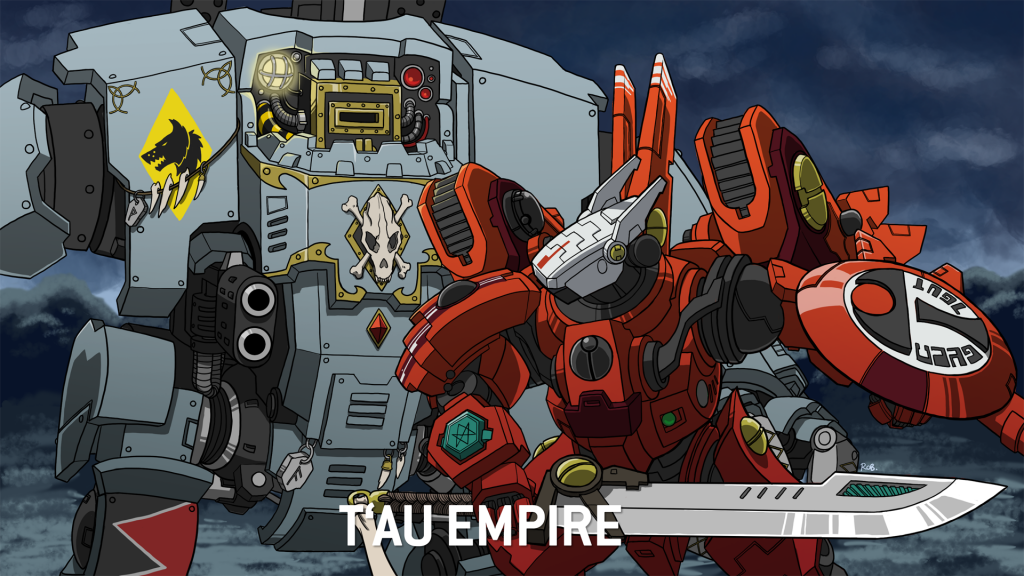
Greg: I’d be lying if I said it didn’t irk me that this is mostly carry-over from the last book. If you read our review of the matched play content from the codex, which is itself mostly carry-over from the index, this is probably not a surprise, as the same approach applies here. I get that this is an early codex, that there are long lead times with printed materials, and that the design space for 10th hasn’t been fully explored yet – it takes time and experience to have ideas, and the designers simply haven’t had that time yet, and certainly didn’t have it months ago when this would have been written. I can understand them not fixing what wasn’t broke, but it feels like a real missed opportunity to do something new and interesting. It’s fine, but that’s all it is.
On a personal note, given that my only two armies are Tau and Dark Angels, it’s nice to have both of their Codexes out already, but it also mega-sucks to have both of their Codexes out already: I just know the later books are going to be much cooler and more inventive than this.
Norman: I pretty much agree with Greg. Even taking this book’s Crusade content on its face without the context of it existing already, the stuff here is pretty dry. There’s a few standouts, but the Battle-Traits all have an issue of having one or two good entries on the table with the rest being situationally helpful, and the Agendas and Requisitions follow much the same path. Any Tau crusade player is definitely going to be excited to have more options, but the rules here get a “Mostly Fine” from me.
Beanith: And it’s a resounding “Eh, it will do” from me as well. I like the setting and the empire building of course. They’re a good set of rules, it’s just a little bit rough its the same stuff from two years previous though.
The Battle Traits were a bit of a let down with all of the battle suits lumped into the same category and no love for Battlesuit characters or Kais’s wierd fascination with gunships.
Major complaints from me are the lack of cool Weapon mods to showcase the T’au superior technology. A Battle Scar table wouldn’t have gone astray either with say your Crisis suit Commander suffering from weak ankles or Stealth suits working a little too well as they vanish off the board.
These ommisions are of course due to limited space available to the Crusade team/intern in each codex. Might I be so bold as to offer a suggestion to Games Workshop… Stop wasting an entire page on the Crusade Badges. Take that nonsense out of the book and stick it on the Warhammer Community download section where it belongs.
Finally as mentioned in my 9th Ed review, for anyone new to running campaigns and wondering how to fit in T’au players taking over entire systems and Genestealers taking over a planet (And Nids eating said planets): That stuff is happening “elsewhere” and the player’s forces present in your campaign are using their success and failures to show the progress of the “main” force overall.
Have any questions or feedback? Drop us a note in the comments below or email us at contact@goonhammer.com. And if you want regular updates in your inbox, subscribe to our newsletter.

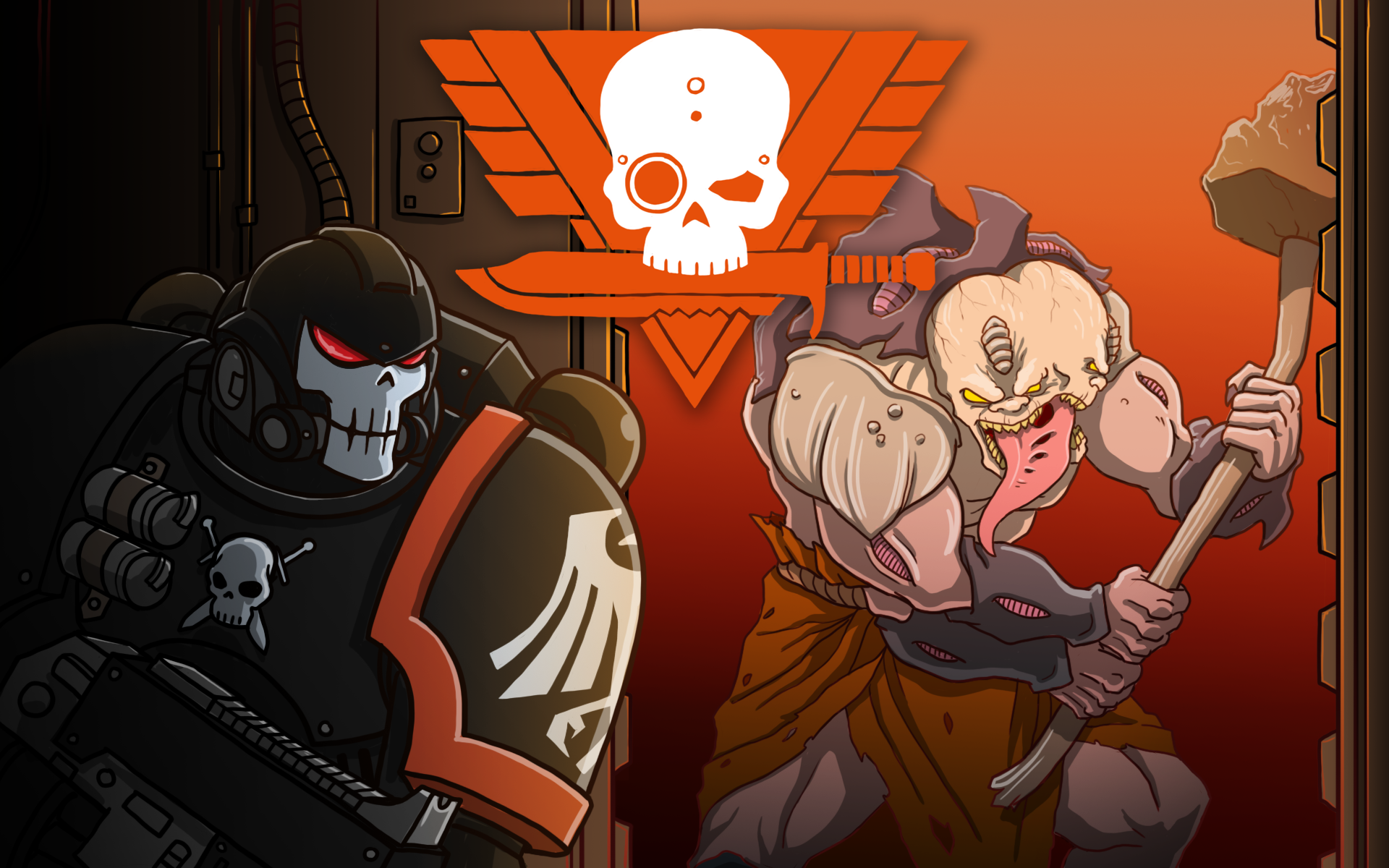


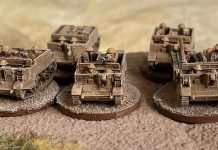




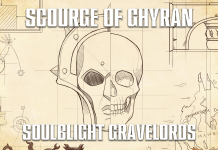
![[40k] Competitive Innovations in 10th: Death Beckons pt.1](https://d1w82usnq70pt2.cloudfront.net/wp-content/uploads/2020/01/Analysis_Banner.png)
